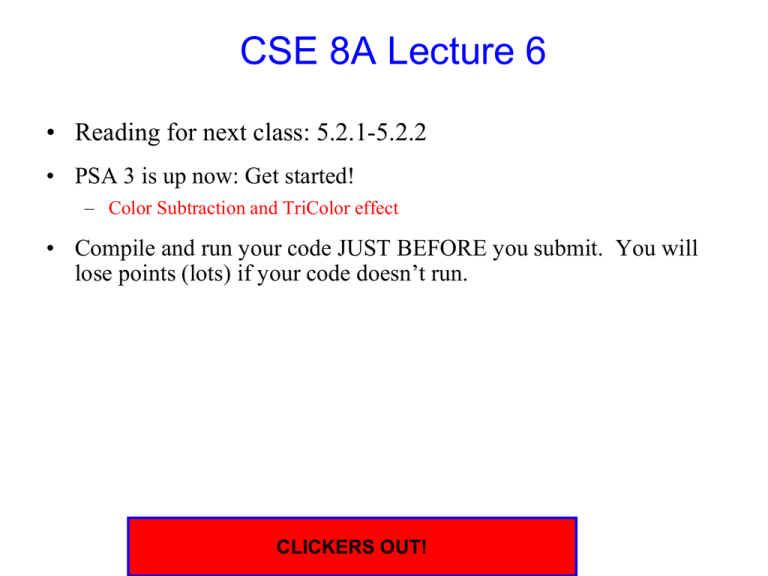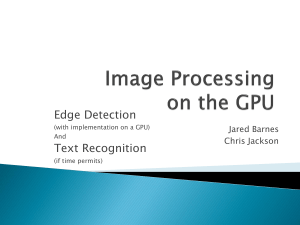CSE8A: Introduction to Programming in Java
advertisement

CSE 8A Lecture 6
• Reading for next class: 5.2.1-5.2.2
• PSA 3 is up now: Get started!
– Color Subtraction and TriColor effect
• Compile and run your code JUST BEFORE you submit. You will
lose points (lots) if your code doesn’t run.
CLICKERS OUT!
1. What line of code would you use to get a
Pixel located at (50,50) from an already
defined Picture object named pictObj?
A. pictObj.getPixel(int 50, int 50);
B. pictObj.getPixel(50,50);
C. pictObj.getPixels();
D. pictObj.getPixels[50][50];
READING QUIZ – NO TALKING – CORRECTNESS MATTERS
2. In the following code what update is
done at the end of each loop iteration?
for (int index = 0; index < 5; index++)
{
//Some code here
}
A. The value of index doesn’t change
B. The value of index is increased by 1
C. The value of index is increased by 2
D. This code produces an error
READING QUIZ – NO TALKING – CORRECTNESS MATTERS
3. Can you have a for-loop in the body
of another for-loop?
A. Yes you can
B. Yes, but you need special code at the top of the file
to be able to do it.
C. No, that will give you a compiler error.
READING QUIZ – NO TALKING – CORRECTNESS MATTERS
4. I have a Picture with a height of 300 pixels and width of
300 pixels. If I want to horizontally mirror the Pixel object
located at (100,100) which Pixel object would I have to
edit?
A. The Pixel object located at (100, 0)
B. The Pixel object located at (0, 100)
C. The Pixel object located at (100,199)
D. The Pixel object located at (199,199)
READING QUIZ – NO TALKING – CORRECTNESS MATTERS
Exam 1
• Median: 85.0
• High score: 10/10 (103 people scored this!)
• If you scored lower than 7.5:
– Don’t panic, you’re lowest score is dropped
– Get help!
– Do the reading, with a partner
– Make sure you really REALLY understand everything
You may not be really understanding…
• Suggestions:
– PLAY with code in the compiler.
• Ask yourself – what will happen if I change this variable value from 5
to 10? Why?
• Type in code from book and change it. But don’t just accept that you
can type it in.
• Do you know WHY greyScale works?
• Do you know WHY negative works?
– Read the book with someone else in class. Talk after every
page.
• Try to explain the text to the other person in your own words
• Don’t “just read” it and think, yeah I get that (you don’t)
– Redo the labs
Exam 1 Review
(1 pt) Why will the following code cause an error?
Assume these statements appear consecutively. Circle
the correct response:
World world1 = new World(200, 100);
Turtle nyla = new Turtle( world1 );
nyla = new Picture();
A. The value assigned to the variable nyla is the wrong
type
B. The variable nyla is declared more than once
C. The constructor for Picture needs an argument (the
name of a file)
D. Once the variable nyla is assigned a value, it cannot be
reassigned to a new value
Exam 1 Review
Your task is to write a method called drawRect that can be
called on an object of type Turtle. The method takes no
parameters, and returns nothing. The method draws a
rectangle whose shorter sides are 50 steps long and whose
longer sides are 100 steps long.
(1 pt) In what file must you define this method?
A.
B.
C.
D.
Turtle.java
Turtle.class
Turtle
File.java
Exam 1 Review
What is wrong with the following definition for drawRect?
public void drawRect()
{
World world1 = new World(200, 100);
Turtle maria = new Turtle(world1);
maria.forward(100);
maria.turnLeft();
maria.forward(50);
maria.turnLeft();
maria.forward(100);
maria.turnLeft();
maria.forward(50);
maria.turnLeft();
}
A.
B.
C.
D.
Nothing is wrong
You shouldn’t create a World object inside the method
You shouldn’t create a Turtle object inside the method
Both B and C
Exam 1 Review
(1 pt) You have a Turtle object stored in a variable named myTurtle. What
line of code will call the method drawRect on that Turtle object?
A. Turtle.drawRect();
B. new Turtle.drawRect();
C. myTurtle.drawRect();
D. myTurtle.drawRect
Exam 1 Review
(2 pts) What does the following code print? Write what is printed on the blank
line next to the line of code that prints it. Assume this code is executed in order.
int num1 = 42;
int num2 = 64;
num2 = num1;
System.out.println( num1 == num2 ); _____________________
num1 = 101;
System.out.println( num2 ); __________________________
A. True 101
B. True 42
C. False 101
D. 42
101
E. 42
42
Exam 1 Review
World world1 = new World(200,200);
Turtle maria = new Turtle(50, 100, world1);
Turtle jose = new Turtle(100, 100, world1);
jose = maria;
maria = new Turtle( 150, 100, world1 );
maria.turn(180);
jose.forward(60);
maria.forward(100);
maria
jose
1) Solo: (1 min )
2) Discuss: (2min)
3) Group: (30 sec)
Swap red and blue values
of each pixel
Pixel[] pixelArray = this.getPixels();
int value = 0;
int index = 0;
while (index < pixelArray.length)
{
Pixel pix = pixelArray[index];
<<CODE GOES HERE>>
index++;
}
value = pix.getRed();
A. pix.setBlue(pix.getRed());
pix.setRed(value);
value = pix.getRed();
C. pix.setRed(pix.getBlue());
pix.setBlue(value);
value = pix.getRed();
B. pix.setBlue(value);
pix.setRed(pix.getBlue());
value = pix.getRed();
D. pix.setRed(value);
pix.setBlue(pix.getRed());
1) Solo: (30 sec)
2) Discuss: (2min)
3) Group: (30 sec)
Why does this code
have an error?
Pixel[] pixelArray = this.getPixels();
Pixel p;
Pixel q;
for(int index = 0; index < pixelArray.length; index++)
{
p = pixelArray[index];
q = pixelArray[index+1];
p.setRed(q.getRed());
p.setBlue(q.getRed());
p.setGreen(q.getGreen());
}
A.
B.
C.
D.
E.
It tries to access pixelArray[-1]
It tries to access pixelArray[0]
It tries to access pixelArray[pixelArray.length]
It tries to access pixelArray[pixelArray.length+1]
None of the above
CS Concept: Variable Tracing
Pixel[] pixelArray = this.getPixels();
Pixel p;
Pixel q;
for(int index = 0; index < pixelArray.length; index++)
{
p = pixelArray[index];
q = pixelArray[index+1];
p.setRed(q.getRed());
p.setBlue(q.getRed());
p.setGreen(q.getGreen());
}
pixelArray
0
index
1
2
3
4
5
1) Solo: (30 sec)
2) Discuss: (2min)
3) Group: (30 sec)
What picture most accurately
describes what this code does ?
Pixel[] pixelArray = this.getPixels();
Pixel p;
Pixel q;
for(int index = 0; index < pixelArray.length-1; index++)
{
p = pixelArray[index];
q = pixelArray[index+1];
p.setRed(q.getRed());
p.setBlue(q.getBlue());
p.setGreen(q.getGreen());
}
A.
B.
C.
D. None
of these
Fill in the for(……) to loop
over pixels bottom right to top left
• Like this:
etc.
next
first
Pixel[] pixArr = this.getPixels();
for (
{
//Some code doing set on pixArr[i]
}
)
1) Solo: (30 sec)
2) Discuss: (2min)
3) Group: (30 sec)
while vs. for vs. for each
• True or False: The following code could be written
using a for-loop.
Pixel[] pixelArray = this.getPixels();
int index = 0;
while ( index < pixelArray.length )
{
Pixel pix = pixelArray[index];
pix.setGreen(255);
index = index + 1;
}
A. True
B. False
while
Pixel[] pixelArray = this.getPixels();
int index = 0;
while ( index < pixelArray.length )
{
Pixel pix = pixelArray[index];
pix.setGreen(255);
index = index + 1;
}
for
Pixel[] pixelArray = this.getPixels();
for ( int index = 0; index < pixelArray.length; index++ )
{
Pixel pix = pixelArray[index];
pix.setGreen(255);
}
for each
Pixel[] pixelArray = this.getPixels();
for ( Pixel pix: pixelArray )
{
pix.setGreen(255);
}
Which do you prefer?
Why?
1) Solo: (30 sec)
2) Discuss: (2min)
3) Group: (30 sec)
while vs. for vs. for each
• So when to use each? Sometimes it’s a matter of
style, sometimes it’s ease of functionality
Choose the best loop to use in each of these situations
A. For
B. For each
C. While
1. You want to loop through a picture until you find a pixel that is all black.
Then you want your loop to stop.
2. You want to loop through all the pixels in a picture and set their red value
equal to their green value
3. You want loop through the pixels in the first half of the picture and make
them all black.
while vs. for vs. for each: Summary
Less chance of
error
• for each
– Use when you know you need to access and modify each
pixel directly
• for
– Use when you need to loop through a known number of
pixels and need access to their index value
• while
Greater chance of
error
– Use when you are not sure how many pixels to loop
through
Often, though, you can just choose the loop you like best
1) Solo: (30 sec)
2) Discuss: (2min)
3) Group: (30 sec)
Nested Loops: How do they work?
What order are pixels changed?
• A method in Picture.java… what does it print if
width is 2 and height is 3?
Pixel p;
for (int foo = 0; foo < getWidth(); foo++)
{
for (int bar = 0; bar < getHeight(); bar++)
{
System.out.println( foo.toString() +“ “+ bar.toString() );
}
turns the variable into a string for printing
}
A 00
01
10
11
20
21
B. 0 0
10
20
01
11
21
C. 0 0
01
02
10
11
12
D. 0 0
11
22
Nested Loops: Tracing code
• A method in Picture.java… what does it print if
width is 2 and height is 3?
Pixel p;
for (int foo = 0; foo < getWidth(); foo++)
{
for (int bar = 0; bar < getHeight(); bar++)
{
System.out.println( foo.toString() + bar.toString() );
}
turns the variable into a string for printing
}
foo
bar
1) Solo: (30 sec)
2) Discuss: (2min)
3) Group: (30 sec)
Nested Loops: How do they work?
What order are pixels changed?
• A method in Picture.java…
Pixel p;
for (int foo = 0; foo < getWidth(); foo++)
{
for (int bar = 0; bar < getHeight(); bar++)
{
p = getPixel(foo, bar);
p.setColor(Color.BLACK);
}
}
What do these Picture methods do?
What are their return types?
• getPixel(int x, int y)
• getHeight()
• getWidth()
1) Solo: (30 sec)
2) Discuss: (2min)
3) Group: (30 sec)
Nested Loops: How do they work?
In what order are pixels changed?
• A method in Picture.java…
Pixel p;
for (int bar = 0; bar < getHeight(); bar++)
{
for (int foo = 0; foo < getWidth(); foo++)
{
p = getPixel(foo, bar);
p.setColor(Color.BLACK);
}
}
1) Solo: (30 sec)
2) Discuss: (2min)
3) Group: (30 sec)
Why does this have an error?
• In a method in Picture.java… assume height=50,width=100
Pixel p;
for (int bar = 0; bar < getWidth(); bar++)
{
for (int foo = 0; foo < getHeight(); foo++)
{
p = getPixel(foo, bar);
p.setColor(Color.BLACK);
}
}
A. It doesn’t, this loops across rows, top to bottom
B. It doesn’t, this loops down columns, left to right
C. It tries to index a pixel off the end of a row (x value
too big)
D. It tries to index a pixel off the end of a column (y
value too big)
TODO
• Get started and do PSA3
• Read next class: 5.2.1-5.2.2
• Do the reading quiz
• PLAY WITH CODE!
– Get stuck, then figure out how to get unstuck – it’s how you learn!








